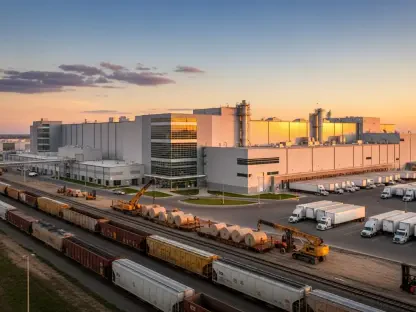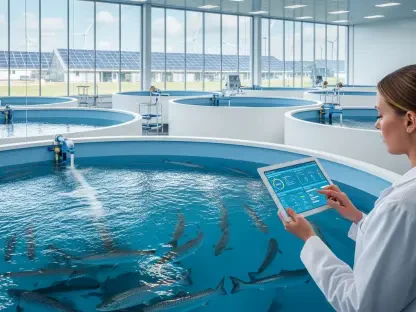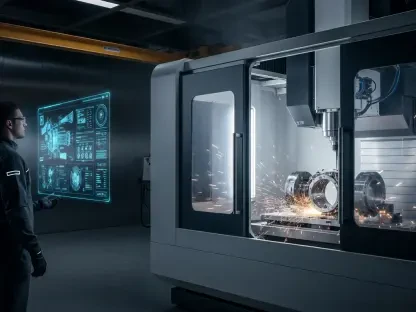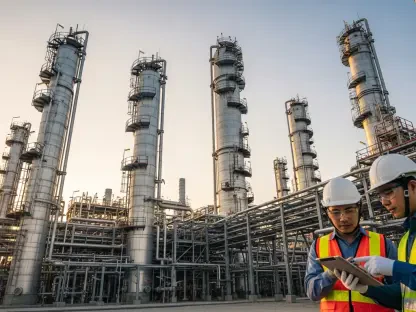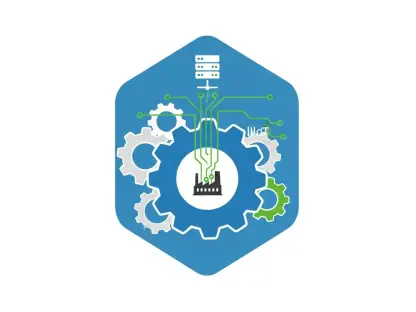In the rapidly advancing world of industrial technology, embodied AI stands out as a transformative force redefining the boundaries of intelligent manufacturing, as highlighted at a major industry event in Shanghai, the China International Industry Fair (CIIF). This innovative technology merges artificial intelligence with physical robotic systems to execute complex tasks in real-world settings. Far beyond the limitations of traditional robotics, embodied AI equips machines with the ability to adapt, learn, and collaborate within dynamic factory environments. This shift is not merely a technological upgrade but a fundamental reimagining of how production lines operate, promising greater efficiency and customization. Shanghai, as the epicenter of this showcase, is carving out a reputation as a global leader in smart manufacturing, backed by ambitious plans to create a multi-billion-dollar industrial hub. This development signals a broader trend where embodied AI is driving both economic growth and technological innovation on an unprecedented scale.
The implications of this transformation are profound, touching on everything from factory floor operations to sustainability and regional collaboration. Exhibits at the CIIF demonstrated robots working seamlessly together, handling materials, and performing intricate tasks with cutting-edge tools. Such advancements reflect a move away from isolated displays toward practical, scalable solutions that address real manufacturing challenges. As industries grapple with rising demands for personalized products, the flexibility offered by embodied AI becomes a critical asset. This technology is no longer a distant vision but a tangible reality, reshaping the industrial landscape with every passing day, and positioning cities like Shanghai at the forefront of a global revolution in smart production systems.
Key Innovations Driving Embodied AI
Flexible Production and Real-World Applications
Embodied AI is revolutionizing manufacturing by introducing flexible production lines that adapt to varying demands with remarkable precision, as showcased at the CIIF in Shanghai. A standout demonstration featured multiple industrial robots operating on a single production line, each performing distinct tasks such as material handling, assembly, and quality checks. Unlike traditional setups where robots follow rigid, synchronized patterns, these systems leverage AI-driven scheduling to function independently while still collaborating effectively. This adaptability allows factories to shift between product types without extensive downtime or reconfiguration, meeting the growing consumer appetite for customized goods. Industry experts at the event noted that such innovations free robots from repetitive monotony, aligning production processes with modern market needs and setting a new standard for operational efficiency in smart manufacturing environments.
Another dimension of this innovation lies in its practical application across diverse industrial scenarios, showcasing a transformative impact on modern manufacturing. Beyond mere demonstrations, the technology displayed at the fair highlighted real-world integration, where robots dynamically respond to unexpected changes on the factory floor. For instance, AI systems enable these machines to adjust their actions based on real-time data, such as variations in material supply or sudden equipment malfunctions. This level of responsiveness is a game-changer for industries aiming to minimize waste and maximize output. Furthermore, the ability to scale these solutions across different sectors—from automotive to electronics—demonstrates the versatility of embodied AI. As manufacturers adopt these systems, the potential for reduced costs and improved productivity becomes increasingly evident, marking a significant leap forward in how industrial processes are conceptualized and executed.
Humanoid Robots and Multi-Robot Coordination
Humanoid robots have emerged as a cornerstone of embodied AI, showcasing their potential to transform factory operations through autonomous and collaborative efforts. At the Shanghai event, companies presented advanced systems where multiple humanoid robots worked together in simulated factory settings, handling tasks like bin sorting and material decomposition. These robots, driven by sophisticated control systems, operate without constant human oversight, coordinating their actions to optimize workflow. This shift from single-unit displays to multi-robot setups reflects a focus on practical utility, mirroring the complex demands of actual production environments. Such advancements indicate that humanoid robots are no longer experimental but are on a fast track toward widespread industrial adoption, promising to redefine labor dynamics in manufacturing.
The industrialization of these systems is accelerating, fueled by rapid technological progress and growing market interest. Unlike earlier prototypes that struggled with basic tasks, current humanoid robots exhibit enhanced dexterity and decision-making capabilities, allowing them to tackle intricate assignments with precision. This progress is evident in their ability to adapt to changing conditions, such as adjusting to new tasks or collaborating with other machines in real time. Industry observers at the fair emphasized that these developments are attracting significant investment, as businesses recognize the potential for humanoid robots to address labor shortages and boost productivity. As these systems become more refined, their integration into everyday manufacturing processes is poised to create smarter, more resilient factories capable of meeting the challenges of a competitive global market.
Sustainability and Smart Industrial Ecosystems
Energy Solutions for AI Factories
As embodied AI reshapes manufacturing, sustainability has become a critical focus, with energy-efficient technologies playing a pivotal role in supporting high-demand industrial systems. At the CIIF, innovative solutions like solid-state transformers and smart microgrids were showcased as vital components for powering AI-driven factories. These next-generation devices offer superior efficiency and compactness compared to traditional power systems, addressing the immense energy needs of modern production facilities and electric vehicle infrastructure. By integrating such technologies, manufacturers can significantly reduce energy waste while maintaining the high computational power required for AI operations. This alignment of operational intelligence with energy conservation marks a crucial step toward building factories that are not only smarter but also more environmentally responsible.
The broader impact of these energy solutions extends to the scalability of smart manufacturing ecosystems, where AI factories consume vast amounts of power for data processing and robotic operations. The adoption of advanced grid systems ensures stability and adaptability under fluctuating loads. Exhibitors at the event highlighted how these innovations enable seamless integration with renewable energy sources, further reducing the carbon footprint of industrial activities. This approach not only addresses immediate energy challenges but also aligns with global sustainability goals, offering a blueprint for future factories. As industries transition to these systems, the potential for cost savings and regulatory compliance grows, reinforcing the importance of energy management as a cornerstone of intelligent manufacturing powered by embodied AI.
Building Smart Ecosystems
The creation of smart industrial ecosystems is a defining feature of the current manufacturing evolution, blending operational advancements with environmental considerations. Embodied AI facilitates this integration by enabling robots and factory systems to work within a network of interconnected technologies, optimizing everything from production schedules to resource allocation. At the Shanghai fair, exhibits demonstrated how AI-driven platforms can coordinate multiple factory functions while incorporating green innovations like energy-efficient machinery. This holistic approach ensures that efficiency gains do not come at the expense of ecological impact, fostering industrial environments where technology and sustainability coexist. Such ecosystems are essential for manufacturers aiming to balance profitability with corporate responsibility in an increasingly eco-conscious market.
Moreover, these ecosystems rely on data-driven insights to continuously improve performance and reduce waste across the production chain. Advanced sensors and AI algorithms monitor energy usage and operational bottlenecks in real time, allowing for immediate adjustments that enhance overall efficiency. This capability was a key highlight at the CIIF, where industry leaders showcased platforms that integrate factory-side AI with smart energy grids to create a seamless operational flow. The result is a manufacturing model that not only meets current demands but also anticipates future challenges, such as resource scarcity or stricter environmental regulations. By prioritizing interconnected systems, the industry is laying the groundwork for a resilient framework that can adapt to evolving global standards while maintaining a commitment to sustainable progress.
Collaborative Efforts and Industry Alliances
Regional and Industry-Wide Partnerships
Collaboration stands as a fundamental pillar in advancing embodied AI within intelligent manufacturing, with regional and industry-wide partnerships driving innovation at an accelerated pace. At the CIIF in Shanghai, the launch of alliances such as the Yangtze River Delta Embodied Intelligence Industry Alliance underscored the importance of shared resources and expertise. This initiative, supported by government and enterprise collaboration, aims to create technology research pools and talent-sharing networks that address development hurdles in embodied intelligence. By fostering cross-regional cooperation, such alliances enable the pooling of diverse perspectives and capabilities, ensuring that breakthroughs are not confined to isolated pockets but benefit the broader industrial landscape. This collective approach is vital for tackling complex challenges in scaling AI-driven manufacturing solutions.
These partnerships also emphasize the role of market-driven operations in sustaining long-term growth. By aligning the interests of various stakeholders—including manufacturers, tech developers, and local authorities—these alliances create a fertile ground for innovation that transcends traditional boundaries. Discussions at the fair highlighted how collaborative frameworks facilitate the exchange of application scenarios, allowing companies to test and refine AI technologies in diverse settings. This not only speeds up the development cycle but also ensures that solutions are practical and widely applicable. As these regional efforts gain traction, they are setting a precedent for how interconnected systems can propel the industry forward, breaking through bottlenecks and establishing new benchmarks for what smart manufacturing can achieve on a global scale.
Building Scalable Platforms
The establishment of scalable platforms is another critical aspect of collaborative efforts, designed to support ambitious economic goals in smart manufacturing. At the Shanghai event, initiatives like the Smart Manufacturing Supply Side Alliance and its associated service platform were introduced to integrate local enterprises, universities, and service providers into a cohesive network. This platform focuses on creating a closed loop for technological breakthroughs, solution implementation, and scalability, aligning with Shanghai’s vision of building a hundred-billion-dollar industrial cluster. By connecting various players in the ecosystem, these platforms ensure that innovations in embodied AI can be rapidly deployed and adapted across different scales of operation, enhancing the overall competitiveness of the region in the global market.
Furthermore, these scalable platforms prioritize accessibility and inclusivity, ensuring that small and medium-sized enterprises can also benefit from cutting-edge AI technologies. At the fair, it was evident that the infrastructure provided by such alliances allows for shared access to advanced tools and research, leveling the playing field for businesses that might otherwise lack the resources to invest heavily in innovation. This democratization of technology fosters a more robust industrial base, where diverse companies contribute to and benefit from the collective progress in intelligent manufacturing. As these platforms expand their reach nationwide, they are poised to create a ripple effect, driving economic growth and technological advancement while reinforcing the importance of collaboration in achieving sustainable industrial success.
Shanghai’s Strategic Vision
A Global Hub for Smart Manufacturing
Shanghai’s emergence as a global hub for smart manufacturing is underpinned by its comprehensive industrial chain and strategic focus on embodied AI, which integrates artificial intelligence into physical systems. The city boasts a robust framework that spans upstream components, midstream manufacturing, and downstream integrated services, creating a fertile ground for innovation. At the CIIF, city officials emphasized Shanghai’s commitment to developing smart terminal products and core technologies like AI algorithm optimization and precise robot control. These efforts have already yielded breakthroughs that rival international standards, positioning the city as a leader in the global landscape of intelligent manufacturing. With a solid foundation and a clear vision, Shanghai is not just participating in the AI revolution but actively shaping its trajectory through targeted investments and policy support.
This leadership is further reinforced by Shanghai’s ability to attract top talent and capital, fueling the growth of its smart manufacturing sector. The city’s industrial agglomeration effect draws in companies and innovators from across the globe, creating a dynamic ecosystem where ideas and technologies converge. Exhibits at the fair showcased how this concentration of resources enables rapid prototyping and deployment of embodied AI solutions, from advanced robotics to integrated factory systems. As Shanghai continues to build on its strengths, it sets an example for other regions aiming to establish themselves in this competitive field. The city’s holistic approach—combining industrial prowess with strategic planning—ensures that it remains at the forefront of transforming manufacturing through intelligent, AI-driven systems.
Urban Planning for Industrial Growth
Shanghai’s forward-thinking urban planning plays a crucial role in fostering industrial growth, particularly in the realm of embodied AI and smart manufacturing, by actively designing layouts that support the development of distinctive industrial clusters. This aligns with national goals for high-quality economic progress. At the Shanghai fair, discussions revealed how urban strategies prioritize the integration of new quality productive forces, ensuring that infrastructure and zoning policies facilitate the expansion of tech-driven industries. This deliberate approach creates environments where innovation can thrive, with dedicated spaces for research, manufacturing, and collaboration. By embedding industrial needs into urban development, Shanghai is crafting a blueprint for sustainable growth that other cities might emulate in the coming years.
Additionally, the focus on urban-industrial synergy enhances Shanghai’s capacity to scale its smart manufacturing initiatives. Policies that streamline access to resources, such as land for factory setups and funding for tech startups, were highlighted at the event as key drivers of progress. These measures ensure that companies working on embodied AI can grow without the usual logistical constraints, fostering an ecosystem where experimentation and implementation go hand in hand. The city’s vision extends beyond immediate gains, aiming to build resilience against future economic and technological shifts. As Shanghai refines its urban planning to support industrial ambitions, it lays the groundwork for a transformative era in manufacturing, where strategic foresight and technological innovation converge to create lasting impact.
Upstream Innovation in Embodied AI
The Role of Component Manufacturers
Upstream innovation is a linchpin in the advancement of embodied AI, with component manufacturers playing an indispensable role in enabling robotic capabilities. At the CIIF in Shanghai, companies showcased critical parts like dexterous hands, motors, and sensors that form the backbone of sophisticated AI-driven systems. These components, often described as the most challenging aspects of robotics, allow machines to perform intricate tasks such as precise grasping and fine manipulation. Their development is not just a technical achievement but a catalyst for broader industrial applications, as they empower robots to handle complex assignments that were previously out of reach. The focus on these upstream elements underscores their importance in building the foundation for the next generation of intelligent manufacturing technologies.
The significance of component manufacturers extends to their partnerships with major industry players, driving the practical adoption of embodied AI. At the fair, it was evident that small-batch supplies of advanced components are already reaching prominent robotics developers, facilitating real-world testing and refinement. This collaborative dynamic accelerates the pace at which new technologies move from concept to production, ensuring that innovations are both cutting-edge and reliable. Moreover, the expertise of these manufacturers in overcoming technical hurdles—such as enhancing the durability and precision of robotic parts—sets the stage for scalability. As upstream players continue to push boundaries, their contributions are shaping a manufacturing landscape where embodied AI can achieve its full potential across diverse sectors.
Commercial Opportunities and Market Interest
The commercial potential for component suppliers in the embodied AI space is surging, driven by significant interest from capital markets. At the Shanghai event, industry analysts noted a marked increase in funding for companies specializing in robotic components over recent years, reflecting confidence in their ability to deliver high-value solutions. This financial backing is crucial for accelerating research and development, enabling suppliers to refine technologies like reducers and advanced sensors that enhance robot functionality. As early adopters in the supply chain, these manufacturers are often the first to capitalize on commercialization opportunities, positioning themselves as key players in the broader adoption of intelligent manufacturing systems. Their success signals a maturing market where upstream innovation translates directly into industrial progress.
Beyond immediate financial gains, the growing market interest highlights a shift in how the industry perceives the value of upstream contributions. Exhibitors at the fair emphasized that investors are increasingly drawn to the long-term potential of components that enable flexibility and autonomy in robotics, viewing them as foundational to future manufacturing trends. This perspective encourages a cycle of innovation, where funding fuels advancements that, in turn, attract further investment. The ripple effect benefits the entire ecosystem, as improved components lead to more capable robots and smarter factories. As capital continues to flow into this sector, the trajectory for embodied AI in manufacturing looks increasingly promising, with component manufacturers at the forefront of transforming technological possibilities into tangible, market-ready solutions.



